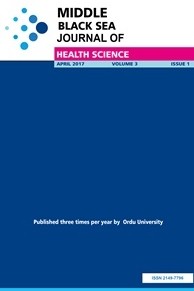The Assessment of the Efficacy of Carboxymethyl Chitosan in the Surgical Treatment of Carpal Tunnel Syndrome: a Retrospective Study
Objective: Carpal Tunnel Syndrome (CTS) is the most commonly encountered entrapment neuropathy of the upper extremity characterized by the compression of the median nerve at the level of the wrist. The objective of the treatment is to eliminate the symptoms stemming from compression and to preserve the neurological function by relieving the median nerve of pressure. Conservative and surgical treatment methods are used effectively in Carpal Tunnel Syndrome. Anti- Adhesion barriers are used during surgery. The aim of this study is to investigate the postoperative effectiveness of carboxymethyl chitosan and methylprednisolone used intraoperatively.Methods: 87 patient files (26 males, 61 female) who were operated with the diagnosis of moderate degree Carpal Tunnel Syndrome. Peroperative local carboxymethyl chitosan gel was applied following the surgical decompression of the transverse carpal ligament in 32 patients, after surgical decompression peroperative local methylprednisolone was applied in 28 patients and only surgical decompression was performed in 27 patients. Preop and post op complaints of patients were evaluated using Symptom Severity Scale (SSS), Functional Status Score (FSS), Boston Symptom Severity Scale (BSSS), Visual Analogue Scale (VAS). Results: When pre and postoperative CNS values were evaluated according to gender and intervention groups, male patients had higher CNS values than female patients (P = 0.046). When preop and postop FSS values were evaluated according to gender and intervention groups, FSS values decreased significantly in all surgical intervention groups compared to preoperative values (P <0.001). When preop and postop VAS scores were assessed with emphasis on sex and intervention groups, VAS scores of the patients in all intervention groups showed a significant decrease as compared to preoperative scores in a time dependent manner (P<0,001).Conclusion: We compared the groups treated with CMCS and methyl prednisolone during surgical interventions for carpal tunnel syndrome with those who had undergone only surgery; we see that there was a significant decrease in the symptoms at three months.
___
- Alkan F, Koc Y, Celik I, Erol M, Aydin M.F. An Experimental Study Evaluating on the Efects of Flunixin Meglumlne and Mepiramine Maleate in the Prevenuon of Intraabdominal Adhesions in Rabbits. Vet Bil journal 2007;21:73-9.
- Burns, J.W., Colt, M.J., Burgees, L.S., Skinner, K.C., Preclinical Evaluation of Seprafilm Bioresorbable Membrane, The European Journal of Surgery. Supplement= Acta Chirurgica. Supplement 1996;577:40-8.
- Carlson H, Colbert A, Frydl J, Arnall E, Elliot M, Carlson N. Current options for nonsurgical management of carpal tunnel syndrome. Int J Clin Rheumtol 2010;5:129-42.
- Chen X, Park H. Chemical characteristics of O-carboxymethyl chito- sans related to the preparation conditions. Carbohydr Polym 2003;53(4):355–59.
- Du XH, Liu JQ, Xin K, Liu GH. Dexamethasone and sodium carboxymethyl cellulose prevent postoperative intraperitoneal adhesions in rats. Braz J Med Biol Res 2015;48(4):344-48.
- Durmus AS, Han MC. Comparison of the effects of different concentrations of sodium carboxymethyl cellulose on prevention of intraabdominal adhesions in rats. Revue Med Vet 2006;157:535-38.
- Durmus AS, Yildiz H, Yaman M, Simsek H. The effects of heparin and pentoxifylline on prevention of intra- abdominal adhesions in rat uterine horn models: histopathological and biochemical evaluations. Revue Med Vet 2011;162:198-203.
- Gelbermen R, Aranson D, Weisman M. Carpal –Tunnel Syndrome. J. Bone and Joint Surg 1980;62:1181-84.
- Gerritsen AA, de Krom MC, Struijs MA et al. Conservative treatment for carpal tunnel syndrome: a systematic review of randomized controlled trials. J Neurol 2002;249:272-80.
- Hadler NM. Nerve entrapment syndromes. In: McCarty DJ, Kopman WJ (Editors). Arthritis and allied conditions. Lea and Febiger: Philadelphia 1993:P.1619-24.
- Holmdahl, L., Eriksson, E., Eriksson, B.I., Risberg, B., Depression of Peritoneal Fibrinolysis During Operation is a Local Response to Trauma, Surgery 1998;123(5): 539-44.
- Koc Y, Alkan F, Uyaroglu A. The use of sodium carboxymethylcellulose in the prevention of intraabdominal adhesions in rabbits. Turk J Vet Anim Sci 2003;27:965-70.
- Liu Q, Huang Y, Lan Y, et al. Acceleration of skin regeneration in full- thickness burns by incorporation of bFGF-loaded alginate microspheres into a CMCS-PVA hydrogel. J Tissue Eng Regen Med 2017;11(5):1562–73. Milligan, D.W., Raftery, A.T. Observations on the Pathogenesis of Peritoneal Adhesions: A Light and Electron Microscopical Study, British Journal of Surgery 1974 ;61(4):274-80.
- Phalen GS. Reflections on 21 years experience with the carpal tunnel syndrome. JAMA; 1970. P. 2365.
- Raftery, A.T., Effect of Peritoneal Trauma on Peritoneal Fibrinolytic Activity and Intraperitoneal Adhesion Formation, European Surgical Research, 1981;13(6). 397-401.
- Rodgers, K.E., Dizerega, G.S., Function of Peritoneal Exudate Cells After Abdominal Surgery, Journal of Investigative Surgery 1993;6(1). 9-23.
- Schnuriger, B., Barmparas, G., Branco, B.C., Lustenberger, T., Inaba, K., Demetriades, D., Prevention of Postoperative Peritoneal Adhesions: A Review of The Literature, The American Journal of Surgery 2011;201(1):111-21.
- Scholten RJ, de Krom MC, Bertelsmann FW et al. Variation in the treatment of carpal tunnel syndrome. Muscle and Nerve 1997; 20: 1334-35.
- Sun BK, Siprashvili Z, Khavari PA. Advances in skin grafting and treatment of cutaneous wounds. Science 2014;346(6212):941–45.
- Ulvi H,Yiğiter R,Aygul R,Varoglu OA. Diagnosis and Treatment Approaches in Carpal Tunnel Syndrome. Van Medical Journal 2004;11(4):155-60.
- Wang G, Lu G, Ao Q, Gong Y, Zhang X. Preparation of cross-linked carboxymethyl chitosan for repairing sciatic nerve injury in rats. Biotechnol Lett 2010;32(1):59–66.
- Yagcı I, Ucan H, Yılmaz L, Yağmurlu F, Keskin D, Bodur H. Efficacy of Kinesiotaping on Symptoms, Hand Functions, and Hand Grip Strength in Carpal Tunnel Syndrome: A Single-Blind and Randomized Controlled Study. Turk J Phys Med Rehabıl 2006;52:55-60.
- Yayın Aralığı: Yılda 4 Sayı
- Başlangıç: 2015
- Yayıncı: Ordu Üniversitesi
Sayıdaki Diğer Makaleler
Nurgül BÖLÜKBAŞ, Yasemin ÖZYER, Dilek ÇİLİNGİR
Serkan GÜNEY, Sercan ERGÜN, Ivana MATIC, Nina PETROVİC, Tatjana STANOJKOVİC
Oya Sevcan ORAK, Ercan TUNÇ, İnci İREN, Merve AKSÖZ
Işılay GEDİK TEKİNEMRE, Burcu KAYHAN TETİK
Fatih ÇAKICI, Elif Bahar ÇAKICI, Alper ILKER, Hüseyin TOPÇUOĞLU
